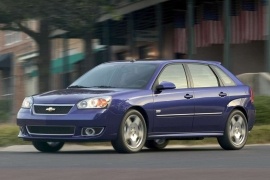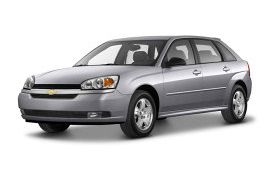CHEVROLET Malibu Maxx Models/Series Timeline, Specifications & Photos
First production year: 2003
Engines: Gasoline
Body style: Wagon (station wagon, estate, combi, touring)
With its experience in producing vehicles for fleets and salesmen, Chevrolet dared to offer a particular version of the Malibu Maxx: the SS.
Chevrolet introduced the sixth generation of the Malibu in 2003 on the same platform as the European Opel/Vauxhall Vectra, but with a longer wheelbase. It was more of a stretched version for it. After two years on the market, GM decided to give a stronger engine and place the SS badge for the Malibu Maxx.
The design department installed a new front fascia for the SS version. The headlights were similar to those from the regular model, but the black mesh-grille featured a chromed surrounding and the bow-tie gold badge in the middle. On the lower side of the apron, the carmaker installed a broad grille and two side scoops for the fog lights. At the back, the raked-forward D-pillars sported an angular look. A roof spoiler adorned the top of the tailgate, while in the sporty-looking bumper, the carmaker installed two chromed exhausts.
Inside, everything was black. Its sport bucket seats with high bolstering gave a clue about the car's performance, and the three-spoke steering wheel just confirmed it. Like the rest of the range, the Maxx SS offered plenty of room for the rear seats, which reclined in three fixed positions and slid back and forth to increase the luggage compartment. With the rear split-folding bench collapsed, the carmaker increased the trunk space from 23 to 41 cubic feet (from 651 to 1160 liters).
Under the hood, GM installed a choice of two engines with either a 3.5-liter or a 3.9-liter displacement, which produced 203 hp or 243 hp, respectively.
Designed as a vehicle fit for any salesman, adequate for any family that couldn't afford an expensive station wagon, or a money-maker for a car rental company, the 2003 Malibu Maxx was a badge-engineering done good example.
Chevrolet developed the Epsilon platform together with Fiat, thus resulting in the European Opel/Vauxhall Vectra, the Italian Fiat Croma, and the Pontiac G6. But GM needed a more affordable vehicle that could sell in high numbers to fleet owners, including car-rental companies. For that, the bow-tie brand made the Malibu Maxx. A car that was a far cry from the original 1964 Malibu.
At the front, the grille was split in two by a horizontal slat that sported the bow-tie badge. In its first two years, that was chromed, but after 2006 Chevrolet dropped that, favoring a body-colored one. Its look resembled the European Vectra C, yet there were different quarter panels and fenders. The added, rack-forward D-pillar at the back made the car look like a mix between a station wagon and a hatchback. It wasn't a design to write home about it.
Chevrolet made the Malibu in a few trim levels, starting with a basic version featuring mediocre plastic panels and amenities. It was the kind of vehicle preferred by salespeople and rental companies. Still, it could be a handy family car thanks to its low running costs. In addition, thanks to its split-folding rear bench fit for three, the Malibu Maxx impressed with its massive trunk space.
Under the hood, GM installed the 2.2-liter gasoline engine for the base trim level but didn't forget to offer an SS version powered by a punchy, 3.9-liter V6.

